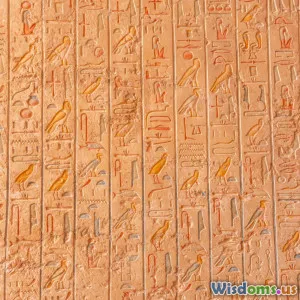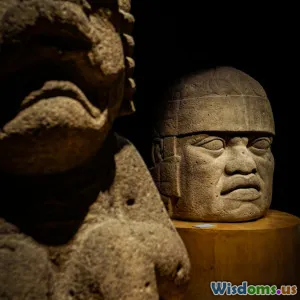
Ancient Scripts: Keys to Understanding Human History
8 min read Explore how ancient scripts unlock the secrets of human history and civilizations. (0 Reviews)
Ancient Scripts: Keys to Understanding Human History
Introduction: The Silent Echoes of Our Ancestors
The whispers of lost civilizations materialize not just through ruins and artifacts, but through the cryptic marks left behind—inscriptions, carvings, and pictographs etched on stone, clay, or parchment. These ancient scripts form humanity’s earliest record of language, culture, and society. They are keys that unlock doors to understanding how primitive humans transformed into complex societies, redefined communication, and shaped the trajectory of history. The study of ancient scripts—deciphering them and contextualizing their meanings—has brought to light the intimate stories of kings, farmers, priests, and pioneers from millennia ago.
Why do these scripts hold such fascination and importance? Because through them, we traverse time and culture, uncovering civilizations that laid foundations for modern law, literature, religion, and governance.
The Dawn of Writing: From Marks to Meaning
Origins of Ancient Scripts
Writing, as a concept, emerged independently in various civilizations around 3200 BCE. The earliest known script is cuneiform, developed by the Sumerians in Mesopotamia. It evolved from simple pictographs used for accounting into complex wedge-shaped characters inscribed on clay tablets.
Simultaneously, ancient Egypt developed hieroglyphics, a rich system combining pictorial and phonetic elements, often carved on temple walls or papyri.
These early scripts share a common origin story: they grew out of the necessity to record economic transactions and administrative tasks in burgeoning city-states. Over time, they transcended utility to express mythology, poetry, and laws.
Beyond Words: The Extent of Ancient Scripting
Writing wasn’t confined to Mesopotamia and Egypt. Ancient civilizations in the Indus Valley, the Maya of Central America, and the Shang dynasty in China developed their unique writing systems. For instance, the Indus script—undeciphered to this day—offers tantalizing glimpses into one of the world’s earliest urban societies.
The Mayan hieroglyphics were deciphered over the past century, collapsing the notion that the Americas lacked complex literate cultures. They provided profound insight into Maya astronomy, history, and governance.
The Journey of Decipherment: Cracking Ancient Codes
The Rosetta Stone and Hieroglyphics
One pivotal moment in unlocking ancient scripts was the discovery of the Rosetta Stone in 1799. This granodiorite stele contained the same text inscribed in Greek, Demotic, and Egyptian hieroglyphs. The Greek text, understood by scholars, provided a crucial reference for Jean-François Champollion to finally decode hieroglyphics in 1822.
The Rosetta Stone illustrated how trilingual inscriptions could serve as linguistic bridges—key to unlocking forgotten languages.
Deciphering Cuneiform
Cuneiform posed a monumental challenge due to its logographic and phonetic components, spanning over 1000 characters. The breakthrough came in the 19th century with scholars like Henry Rawlinson, who studied inscriptions such as the Behistun Inscription in present-day Iran. This trilingual relief carved by Darius the Great functioned similarly to the Rosetta Stone.
Understanding cuneiform not only revealed Sumerian and Akkadian languages but also illuminated the legal codes (like Hammurabi's) that shaped governance and justice.
The Challenges of Undeciphered Scripts
Numerous scripts remain mysteries. The Indus script, with its short inscriptions and lack of bilingual texts, continues to baffle researchers. Similarly, the Linear A script from Minoan Crete is still not deciphered, blocking a full understanding of early European literacy.
These unresolved scripts remind us how linguistic heritage can be lost to time, emphasizing the precious nature of successful decipherment.
Scripts as Windows to Ancient Lives
Insight into Religion and Mythology
Ancient scripts uncovered vast religious traditions. The Epic of Gilgamesh, recorded in Akkadian cuneiform on clay tablets, is among the oldest known literary works, exploring themes of heroism, mortality, and friendship.
Hieroglyphic texts like the Book of the Dead reveal Egyptian beliefs about the afterlife. These writings illustrate how civilizations grappled with existence, divine worship, and morality.
Economic and Political Documentation
Scripts were crucial for administration. The Code of Ur-Nammu and later Hammurabi’s Code provide detailed laws, penalties, and social contracts.
Tax records, trade agreements, and census data uncovered through texts demonstrate the complexity of ancient economies and political institutions, revolutionizing how historians see these societies.
Linguistic Heritage and Modern Languages
Many modern languages derive roots from these ancient scripts and tongues. Semitic languages owe alphabets to Phoenician scripts, which in turn influenced Greek, Latin, and eventually contemporary European scripts.
Understanding these linguistic evolutions traces cultural exchange and the spread of knowledge, highlighting the interconnectedness of civilizations.
The Technological and Cultural Impact of Ancient Scripts
Innovations in Writing Materials and Instruments
Ancient scribes innovated with materials like clay tablets, papyrus, parchment, and ink. The transition from stone carving to ink on paper allowed faster communication and broader dissemination.
The invention of the alphabet, for example by the Phoenicians around 1050 BCE, simplified writing, making literacy more accessible—a democratizing development with profound cultural consequences.
Preservation of Knowledge Through Scripts
Ancient scripts preserved not only cultural memory but scientific, astronomical, and medical knowledge. The Babylonian astronomical tablets informed later Greek and Islamic astronomy.
Chinese oracle bones recorded divinations, which alongside Confucian texts shaped Chinese thought and governance frameworks lasting millennia.
Conclusion: Unearthing Our Shared Past Through Scripts
Ancient scripts represent humanity’s first profound attempts to externalize thought, record experience, and communicate across generations. Each deciphered script bridges millions of years, transforming silence and enigma into a dialogue with the past.
In an era of digital communication, the study of ancient writing reminds us that written language remains a powerful tool for preserving human civilization’s intangible heritage. They not only document history but inspire us—to cherish cultural diversity, to appreciate wisdom inherited, and to continue unlocking mysteries about ourselves and our origins.
The keys to understanding human history lie etched in stone, clay, and parchment—waiting for the curious and the diligent to decode their timeless secrets.
Rate the Post
User Reviews
Other posts in Historical Linguistics
Popular Posts
















